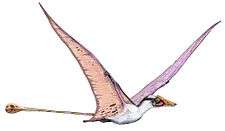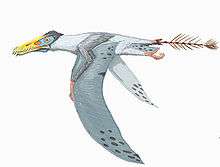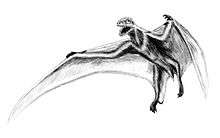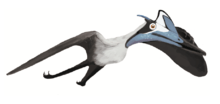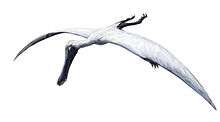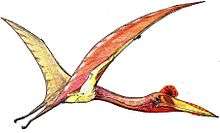Maaradactylus
Maaradactylus is a genus of anhanguerid pterodactyloid pterosaur known from the Lower Cretaceous period (Aptian to Albian stages) of the Romualdo Formation of northeastern Brazil.
| Maaradactylus | |
|---|---|
 | |
| Reconstructed skeleton of the species M. spielbergi | |
| Scientific classification | |
| Kingdom: | Animalia |
| Phylum: | Chordata |
| Order: | †Pterosauria |
| Suborder: | †Pterodactyloidea |
| Family: | †Anhangueridae |
| Genus: | †Maaradactylus Bantim et al., 2014 |
| Type species | |
| †Maaradactylus kellneri Bantim et al., 2014 | |
| Other species | |
| |
| Synonyms | |
|
Synonyms of M. spielbergi
| |
Discovery

Maaradactylus is based on the Museu Paleontologico de Santana do Cariri specimen MPSC R 2357, a skull, atlas, and axis discovered in 2010 in the Aptian—Albian-age Romualdo Formation of Sítio São Gonçalo, Santana do Cariri, Ceará, in the Araripe Basin of Brazil.
Maaradactylus was described by Renan Bantim and colleagues in 2014. The type species is Maaradactylus kellneri. The generic name refers to Maara, in the legends of the Cariri the daughter of a chief, by sorcery changed into a river monster with long teeth, devouring fishermen. The suffix ~dactylus is common in the names of pterosaurs and is derived from Greek δάκτυλος, daktylos, "finger", referring to the long (fourth) wing finger. The specific name honours Alexander Kellner, Brazil's foremost pterosaur expert.[1]
In 2019, the species Coloborhynchus spielbergi was assigned to Maaradactylus by Megan L. Jacobs and colleagues as M. spielbergi, the specific name was named after the filmmaker Steven Spielberg, the director of Jurassic Park.[2]
Description
Maaradactylus had one of the largest anhanguerid skulls from the Santana Group, and this indicated a wingspan estimate of about six metres. This anhanguerid also has a relatively tall crest running along the midline of the premaxillary bones, which make up most of the upper beak region, and placements for 35 pairs of teeth in the upper jaws.[1]
The formerly known Coloborhynchus spielbergi, now Maaradactylus spielbergi, had rounded crests at the ends of expanded upper and lower jaws, similar to the related ornithocheirids.[3] However, rather than the crests being robust and box-shaped as seen in many ornithocheirid genera, the jaw tips were more slender and spoon-shaped, and the crest is thin from top to bottom, both features commonly seen in anhanguerid species typically referred to the genus Anhanguera, a genus in which M. speilbergi was classified by some researchers as A. spielbergi. As in other ornithocheirids, the size and orientation of the teeth vary considerably along the jawline. In M. spielbergi, the tooth pattern has been described as more similar to Anhanguera rather than to Tropeognathus.[2]
Classification
The cladogram below is a topology recovered by Jacobs et al. (2019). In the analysis, they recovered Maaradactylus within the family Anhangueridae, and as the sister taxon of several Anhanguera species.[4]
| Ornithocheirae |
| ||||||||||||||||||||||||||||||
References
- Renan A. M. Bantim; Antônio A. F. Saraiva; Gustavo R. Oliveira; Juliana M. Sayão (2014). "A new toothed pterosaur (Pterodactyloidea: Anhangueridae) from the Early Cretaceous Romualdo Formation, NE Brazil". Zootaxa. 3869 (3): 201–223. doi:10.11646/zootaxa.3869.3.1. PMID 25283914.
- Jacobs, Megan L.; Martill, David M.; Ibrahim, Nizar; Longrich, Nick (2019). "A new species of Coloborhynchus (Pterosauria, Ornithocheiridae) from the mid-Cretaceous of North Africa". Cretaceous Research. 95: 77–88. doi:10.1016/j.cretres.2018.10.018.
- Veldmeijer, A.J., H.J.M. Meijer, and M. Signore (2006). "Coloborhynchus from the Lower Cretaceous Santana Formation, Brazil (Pterosauria, Pterodactyloidea, Anhangueridae); an update." PalArch’s Journal of Vertebrate Palaeontology, 3(2): 15-29.
- Jacobs, M.L., Martill, D.M., Ibrahim, N., Longrich, N. (2019). "A new species of Coloborhynchus (Pterosauria, Ornithocheiridae) from the mid-Cretaceous of North Africa" (PDF). Cretaceous Research. doi:10.1016/j.cretres.2018.10.018.CS1 maint: uses authors parameter (link)
